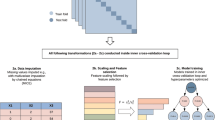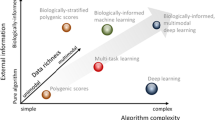Abstract
Machine learning techniques present with a great deal of promise in forensic psychiatry to predict patient outcomes at an individual level; however, the field currently remains in its infancy. The present chapter provides an overview of predictive models of criminal and violence-related outcomes in psychiatry, as well as the feigning of serious mental illness following arrest to avoid prison sentences. Moreover, this chapter details various machine learning techniques and experimental designs that can be leveraged to address long-standing problems within the field. As such, it aims to provide a series of methodological recommendations for moving the field from advancements in risk prediction towards precision forensics.
Access this chapter
Tax calculation will be finalised at checkout
Purchases are for personal use only
Similar content being viewed by others
References
Zitrin A, Hardesty AS, Burdock EI, Drossman AK. Crime and violence among mental patients. Am J Psychiatry. 1976;133(2):142–9. https://doi.org/10.1176/ajp.133.2.142.
Klassen D, O’Connor WA. Crime, inpatient admissions, and violence among male mental patients. Int J Law Psychiatry. 1988;11(3):305–12. https://doi.org/10.1016/0160-2527(88)90017-9.
Fazel S, Seewald K. Severe mental illness in 33 588 prisoners worldwide: systematic review and meta-regression analysis. Br J Psychiatry. 2012;200(5):364–73. https://doi.org/10.1192/bjp.bp.111.096370.
Mullen PE, Burgess P, Wallace C, Palmer S, Ruschena D. Community care and criminal offending in schizophrenia. Lancet. 2000;355(9204):614–7. https://doi.org/10.1016/S0140-6736(99)05082-5.
Simpson AIF, et al. Homicide and mental illness in New Zealand, 1970-2000. Br J Psychiatry. 2004;185:394–8. https://doi.org/10.1192/bjp.185.5.394.
Hodgins S, Alderton J, Cree A, Aboud A, Mak T. Aggressive behaviour, victimisation and crime among severely mentally ill patients requiring hospitalisation. Br J Psychiatry. 2007;191:343–50. https://doi.org/10.1192/bjp.bp.106.06.029587.
Chang Z, Larsson H, Lichtenstein P, Fazel S. Psychiatric disorders and violent reoffending: a national cohort study of convicted prisoners in Sweden. Lancet Psychiatry. 2015;2(10):891–900. https://doi.org/10.1016/S2215-0366(15)00234-5.
Chang Z, Lichtenstein P, Langström N, Larsson H, Fazel S. Association between prescription of major psychotropic medications and violent reoffending after prison release. JAMA. 2016;316(17):1798–807. https://doi.org/10.1001/jama.2016.15380.
Coid JW, et al. Psychiatric diagnosis and differential risks of offending following discharge. Int J Law Psychiatry. 2015;38:68–74. https://doi.org/10.1016/j.ijlp.2015.01.009.
Coid J, Mickey N, Kahtan N, Zhang T, Yang M. Patients discharged from medium secure forensic psychiatry services: reconvictions and risk factors. Br J Psychiatry. 2007;190:223–9. https://doi.org/10.1192/bjp.bp.105.018788.
Morgan VA, et al. A whole-of-population study of the prevalence and patterns of criminal offending in people with schizophrenia and other mental illness. Psychol Med. 2013;43(9):1869–80. https://doi.org/10.1017/S0033291712002887.
Moore KE, et al. Psychiatric disorders and crime in the US population: results from the national epidemiologic survey on alcohol and related conditions wave III. J Clin Psychiatry. 2019;80(2):18m12317. https://doi.org/10.4088/JCP.18m12317.
Fazel S, Grann M. The population impact of severe mental illness on violent crime. Am J Psychiatry. 2006;163(8):1397–403. https://doi.org/10.1176/ajp.2006.163.8.1397.
Clark T. Review of Forensic psychiatry: clinical, legal and ethical issues (2nd edn). Br J Psychiatry. 2015;206(1):82–3. https://doi.org/10.1192/bjp.bp.114.150524.
Murray J, Thomson DME. Clinical judgement in violence risk assessment. Eur J Psychol. 2010;6(1):128. https://doi.org/10.5964/ejop.v6i1.175.
Sreenivasan S, Kirkish P, Garrick T, Weinberger LE, Phenix A. Actuarial risk assessment models: a review of critical issues related to violence and sex-offender recidivism assessments. J Am Acad Psychiatry Law. 2000;28(4):438–48.
Hart SD, Michie C, Cooke DJ. Precision of actuarial risk assessment instruments: evaluating the ‘margins of error’ of group v. individual predictions of violence. Br J Psychiatry. 2007;49:s60–5. https://doi.org/10.1192/bjp.190.5.s60.
Thomson L, Davidson M, Brett C, Steele J, Darjee R. Risk assessment in forensic patients with schizophrenia: the predictive validity of actuarial scales and symptom severity for offending and violence over 8 – 10 years. Int J Forensic Ment Health. 2008;7(2):173–89. https://doi.org/10.1080/14999013.2008.9914413.
McNeil AJ, Frey R, Embrechts P. Quantitative risk management: concepts, techniques, and tools. J Am Stat Assoc. 2005;101(476):1731–2. https://doi.org/10.1198/jasa.2006.s156.
Jed Frees EW, Derrig RA, Meyers G. Predictive modeling in actuarial science. In: Predictive modeling applications in actuarial science: vol. I: predictive modeling techniques. 2014. https://doi.org/10.1017/CBO9781139342674.001.
Gerds TA, Cai T, Schumacher M. The performance of risk prediction models. Biom J. 2008;50(4):457–79. https://doi.org/10.1002/bimj.200810443.
Bennett KP, Parrado-Hernández E. The interplay of optimization and machine learning research. J Mach Learn Res. 2006;7:1265–81.
Doshi-Velez F, Kim B. Towards a rigorous science of interpretable machine learning. 2017. p. 1–13.
Cheng TH, Wei CP, Tseng VS. Feature selection for medical data mining: comparisons of expert judgment and automatic approaches. In: Proceedings—IEEE symposium on computer-based medical systems; 2006. https://doi.org/10.1109/CBMS.2006.87.
Bolón-Canedo V, Sánchez-Maroño N, Alonso-Betanzos A. Feature selection for high-dimensional data. Prog Artif Intell. 2016;5:65–75. https://doi.org/10.1007/s13748-015-0080-y.
Eher R, Rettenberger M, Matthes A, Boer DP. Prospective actuarial risk assessment: a comparison of five risk assessment instruments in different sexual offender subtypes. Int J Offender Ther Comp Criminol. 2010;54(2):169–86. https://doi.org/10.1177/0306624X08328755.
Delfin C, et al. Prediction of recidivism in a long-term follow-up of forensic psychiatric patients: incremental effects of neuroimaging data. PLoS One. 2019;14(5):e0217127. https://doi.org/10.1371/journal.pone.0217127.
Kirchebner J, Sonnweber M, Nater UM, Günther M, Lau S. Stress, schizophrenia, and violence: a machine learning approach. J Interpers Violence. 2020;37(1–2):602–22. https://doi.org/10.1177/0886260520913641.
Cope LM, et al. Abnormal brain structure in youth who commit homicide. Neuroimage Clin. 2014;4:800–7. https://doi.org/10.1016/j.nicl.2014.05.002.
Haarsma G, et al. Assessing risk among correctional community probation populations: predicting reoffense with mobile neurocognitive assessment software. Front Psychol. 2020;10:2926. https://doi.org/10.3389/fpsyg.2019.02926.
Vilares I, et al. Predicting the knowledge-recklessness distinction in the human brain. Proc Natl Acad Sci U S A. 2017;114(12):3222–7. https://doi.org/10.1073/pnas.1619385114.
Fortunati F, Southwick S, Temporini H, Morgan CA. Malingering and forensic psychiatry. Psychiatry. 2005;2(12):25–8.
Rumschik SM, Appel JM. Malingering in the psychiatric emergency department: prevalence, predictors, and outcomes. Psychiatr Serv. 2019;70:115–22.
Monaro M, et al. The detection of malingering: a new tool to identify made-up depression. Front. Psychiatry. 2018; https://doi.org/10.3389/fpsyt.2018.00249.
Mazza C, et al. Introducing machine learning to detect personality faking-good in a male sample: a new model based on Minnesota multiphasic personality inventory-2 restructured form scales and reaction times. Front Psychiatry. 2019;9:249. https://doi.org/10.3389/fpsyt.2019.00389.
Pace G, et al. Malingering detection of cognitive impairment with the b test is boosted using machine learning. Front Psychol. 2019;10:1650. https://doi.org/10.3389/fpsyg.2019.01650. PM: 31396127.
Kotsiantis SB. Feature selection for machine learning classification problems: a recent overview. Artif Intell Rev. 2011;42:157. https://doi.org/10.1007/s10462-011-9230-1.
Raghu V, Ge X, Chrysanthis P, Benos P. Integrated theory- and data-driven feature selection in gene expression data analysis. Proc Int Conf Data Eng. 2017;1525–1532 https://doi.org/10.1109/ICDE.2017.223.
Palijan TŽ, Mužini L, Radeljak S. Psychiatric comorbidity in forensic psychiatry. Psychiatria Danubina. 2009;21:429–36.
Kay SR, Qpjer LA. The positive and negative syndrome scale (PANSS) for schizophrenia. Schizophr Bull. 1982;13(2):261–76.
Young RC, Biggs JT, Ziegler V, Meyer DA. A rating scale for mania: reliability, validity and sensitivity. Br J Psychiatry. 1978;133:429–35.
Davidson J, Turnbull CD, Strickland R, Miller R, Graves K. The Montgomery-Asberg Depression Scale: reliability and validity. Acta Psychiatr Scand. 1986;73:544–8.
Lally J, Gaughran F, Timms P, Curran SR. Treatment-resistant schizophrenia: current insights on the pharmacogenomics of antipsychotics. Pharmgenomics Pers Med. 2016;117–129
Conley RR, Kelly DL. Management of treatment resistance in schizophrenia. Biol Psychiatry. 2001;50:898–911.
Grira N, Crucianu M, Boujemaa N. Unsupervised and semi-supervised clustering: a brief survey. A Rev Mach Learn Tech Process Multimed Content, Rep MUSCLE Eur Netw Excell. 2004; https://doi.org/10.1021/jp303679y.
Insel TR, Cuthbert BN. Brain disorders? Precisely: precision medicine comes to psychiatry. Science. 2015;348(6234):499–500. https://doi.org/10.1126/science.aab2358.
Grira N, Crucianu M, Boujemaa N, Rocquencourt I. Unsupervised and semi-supervised clustering: a brief survey. A Rev Mach Learn Tech Process Multimed Content. 2005;1–12
Sundararajan M, Najmi A. The many Shapley values for model explanation. In: International conference on machine learning; 2020.
Lundberg SM, et al. From local explanations to global understanding with explainable AI for trees. Nat Mach Intell. 2020;2:56–67. https://doi.org/10.1038/s42256-019-0138-9.
Author information
Authors and Affiliations
Editor information
Editors and Affiliations
Rights and permissions
Copyright information
© 2023 The Author(s), under exclusive license to Springer Nature Switzerland AG
About this chapter
Cite this chapter
Watts, D. (2023). The Use of Machine Learning Techniques to Solve Problems in Forensic Psychiatry. In: Passos, I.C., Rabelo-da-Ponte, F.D., Kapczinski, F. (eds) Digital Mental Health. Springer, Cham. https://doi.org/10.1007/978-3-031-10698-9_14
Download citation
DOI: https://doi.org/10.1007/978-3-031-10698-9_14
Published:
Publisher Name: Springer, Cham
Print ISBN: 978-3-031-10697-2
Online ISBN: 978-3-031-10698-9
eBook Packages: Behavioral Science and PsychologyBehavioral Science and Psychology (R0)




